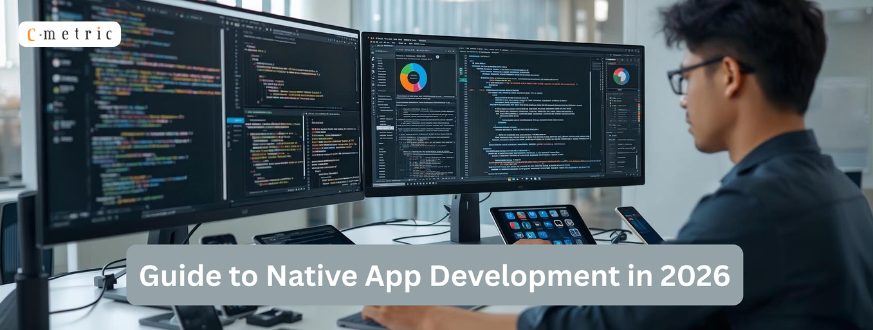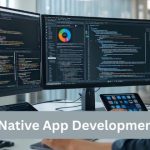Mobile app development is booming right now. In USA, over 93% of people use smartphones, and they spend more than 4.2 hours on apps. These stats show that this is an amazing chance for businesses and app developers to capitalize on.
Market data shows the mobile app industry in USA had a value of USD 22.8 billion in 2024. Experts predict it will grow to USD 52.5 billion by 2030, with a CAGR of 15.3%. On a global scale, the mobile app development field is set to expand from USD 94.4 billion in 2024 to USD 399.8 billion by 2032. Competing in this field takes more than knowing technology alone. Performance optimization plays a key role because even a one-second delay in app load times can cut conversions by as much as 20%. Such facts highlight why considering speed is vital when putting together mobile app strategies.
This blog post dives into hands-on ways and tips to design successful mobile apps in 2026. It covers everything from the start of planning to the post-launch stage.
Sure-Shot Tips Across Different Stages for Building Mobile Apps in 2026
Below are some of the best tips we’ve outlined for you to follow at each stage of building a mobile app in 2026. Read till the end to discover key methods for creating apps that go beyond simply meeting user needs.
Planning and Strategy Phase
Good planning is crucial to making a mobile app successful. Studies indicate that the global mobile app market could hit USD 626.39 billion by 2030 growing at a steady 14.3% every year. With this rapid expansion, making sure your idea is solid becomes more important than ever.
First, identify the main issue your app will solve and check if your idea holds up by asking direct feedback from real users. Build profiles that detail your potential users’ age, location, device choices, and habits. This helps you know who your app is aimed at. Talking to around 50 to 100 people who might use your app makes it clear which features are must-haves for your MVP.
After that, dive deep into studying your competition. Look into the top 5 to 10 apps in your field to see their key features, pricing strategies, and user feedback. You can use tools like Google AdWords to find out if people are searching for solutions similar to yours.
When choosing best mobile app tech stack, keep these points in mind:
- The time it will take to build and how much money you can spend
- The skills your team has with certain tools and technologies
- Whether the app will need to grow or expand later
- How well the tech meets the needs of your app
Privacy rules like GDPR and CCPA require clear permission to collect data. upcoming laws such as the Texas App Store Accountability Act (starting in January 2026) will need platforms to include tools to verify a user’s age and get permission from parents.
Involving 5-7 users in early testing can reveal most usability problems before launch. This helps teams keep improving designs during the entire creation process.
Development and Design Execution
Picking the right tools and systems is key to building software. Cross-platform tools are becoming more popular, and Flutter stands out because of its quick reload feature and its ability to convert code for ARM or Intel processors.
When choosing the best mobile app framework, start by thinking about your team’s skill set and the support that framework maintainers will provide over time. Flutter, Kotlin Multiplatform, and SwiftUI each have their own strengths based on what your project needs. Flutter works well when creating animation-heavy apps or when start-ups need fast MVPs, thanks to its smooth UI powered by the Skia engine.
You should build accessibility right into the design process instead of treating it as an afterthought. Make sure your app can handle larger text sizes allowing up to 200% scaling, and that it sticks to colour contrast ratios of at least 4.5:1 for text under 17 points. Also, design controls that are large enough, with iOS and iPadOS needing at least 28×28 pt as the minimum size.
Optimizing performance matters just as much. Speed up load times by improving code using lazy loading, and compressing images well. Studies reveal that 53% of people leave mobile sites if loading takes more than three seconds.
To focus on gesture navigation, prioritize edge-to-edge content while avoiding issues in gesture areas. According to data, half of Android users depend on the Back button even more than the Home button so integrating this is important.
App Launch, User Feedback, and Scaling
Launching an app needs strong security steps and smart ways to collect feedback. Security should come first. In 2024, 56% of mobile apps failed to store private data. Use encryption secured access, and conduct regular security checks to avoid costly fixes as your app gains more users.
To implement analytics, Google Analytics offers free reporting on 500 unique events without any limit. This platform gives important insights into user behaviour across both iOS and Android apps. These insights help make better choices to improve products. You can also send raw data to BigQuery to analyse it your way.
It is important to collect feedback in context. Run surveys while users still remember their experiences to get more useful results. Try different methods to gather feedback such as:
- Surveys within the app
- Feedback tools
- Recordings of sessions and heat maps
Most, make sure to close the feedback loop. Research reveals that 87.8% of users who got replies to their feedback said they were more inclined to stay loyal to the brand, 89.2% of individuals whose issues were resolved expressed a better overall opinion of the brand.
As your business grows, keep an eye on frequent data leakage areas during mobile app development. Pay attention to things like HTML5 data storage, browser cookie objects, and background processes in apps. Growing means finding the right balance between expansion keeping security strong, and listening to what users have to say.
Conclusion
Creating mobile apps offers significant business opportunities, especially as the market is projected to reach USD 626.39 billion by 2030. Success relies on careful planning, user feedback, and competitor analysis. Developers must prioritize technical design, performance, and accessibility from the start. Post-launch, focusing on security and ongoing feedback is essential. By balancing user needs, technical limits, and market demands, mobile apps can drive growth, solve problems, and engage users effectively.
Making a mobile app successful means managing a lot of moving parts, including what users want, technical constraints, market demands, and the rules you need to follow. But if done right mobile apps offer unique ways to solve problems, please users, and grow a strong business. These strategies from C-metric serve as a guide for handling those challenges and increasing your chances of success in the fast-paced field of mobile apps. Partner with us, a top-notch mobile app development service provider, and we can help you transform your app idea into reality. We specialize in creating cutting-edge mobile applications that seamlessly function across multiple devices and platforms.













Get in Touch